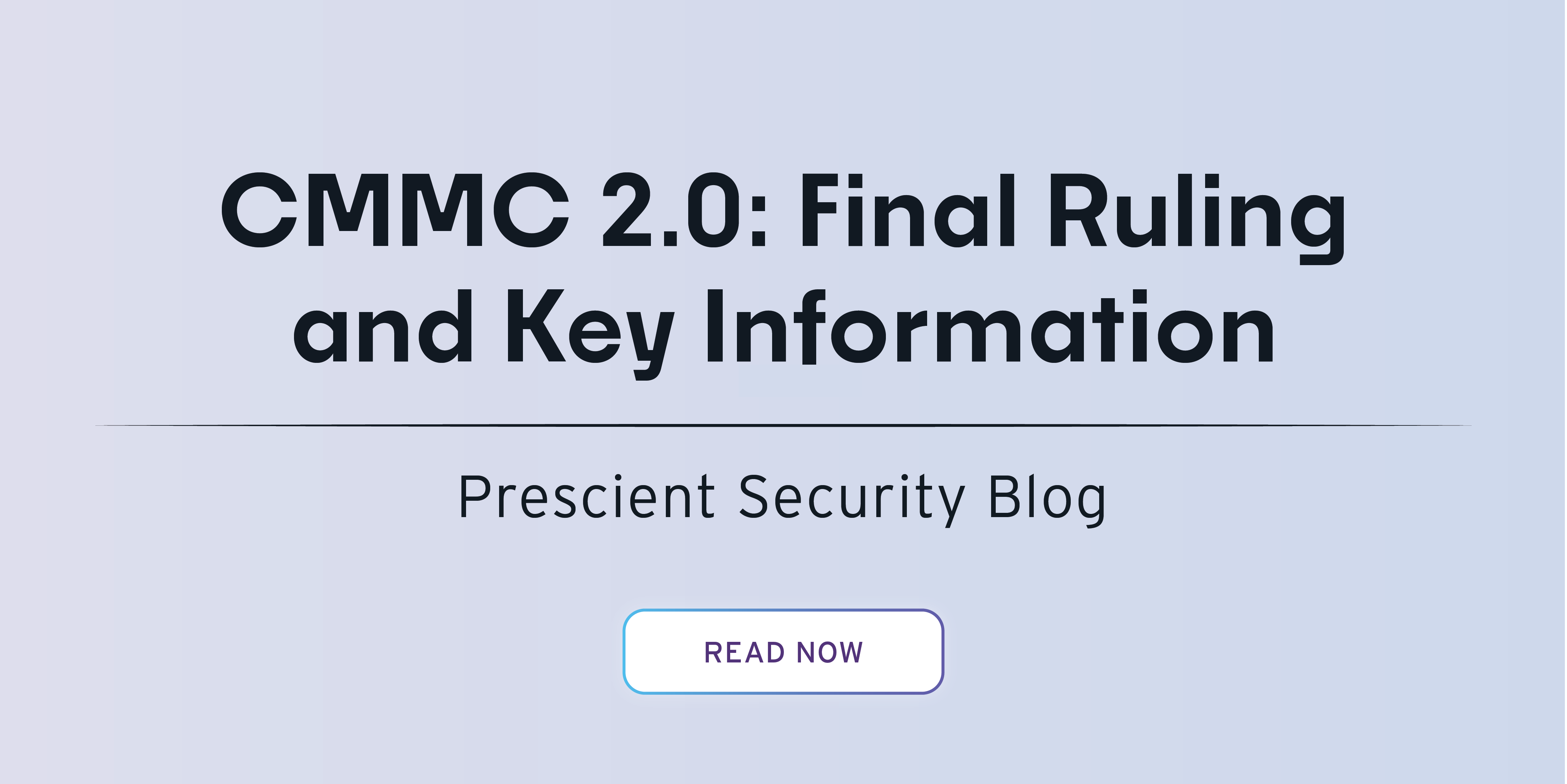Cybersecurity as an Investment: Understanding the ROI of Penetration Testing
Cybersecurity continues to be an investment area for businesses of all sizes. With the increasing frequency and sophistication of cyberattacks, protecting sensitive data and maintaining the integrity of digital assets are paramount. Companies must shift their perspective and view cybersecurity not just as a cost but, as a strategic investment that will safeguard their future.
Contents
- How Does Cybersecurity Safeguard An Organization's Future?
- What Is The Primary Purpose Of Penetration Testing?
- The Financial Impact Of Cybersecurity Breaches
- The ROI of Penetration Testing
- Implementing Penetration Testing In Your Organization
- Measuring And Communicating The ROI
- Prescient Security and Penetration Testing
How Does Cybersecurity Safeguard An Organization's Future?
The Protection of Critical Assets
Organizations today rely heavily on digital assets, from customer data and intellectual property to financial information and operational systems. A cybersecurity strategy ensures these critical assets are protected from cyber threats that could result in data breaches, financial losses, and operational disruptions.
Maintaining Business Continuity
Cyberattacks can significantly interrupt business operations. By investing in robust cybersecurity measures, organizations can prevent or mitigate the effects of attacks, ensuring that business processes continue smoothly without costly downtime.
Building Customer Trust and Confidence
Customers expect their data to be handled securely. Effective cybersecurity practices, including regular penetration testing, demonstrate an organization’s commitment to protecting customer information. This builds trust and confidence, enhancing customer loyalty and attracting new clients.
Complying with Regulations
Regulatory compliance is essential in many industries. Non-compliance can result in severe penalties, legal action, and reputational damage. Investing in cybersecurity helps organizations meet regulatory requirements and avoid the consequences of non-compliance.
Preventing Financial Losses
The financial impact of a cyberattack can be devastating, ranging from direct costs like remediation and legal fees to indirect costs such as lost revenue and reputational damage. Penetration testing can identify vulnerabilities before they are exploited, preventing breaches and the associated financial fallout.
Gaining Competitive Advantage
Organizations with solid cybersecurity measures can differentiate themselves. By demonstrating a proactive approach to security, businesses can earn a competitive edge, attract security-conscious customers, and potentially command a premium for their products or services.
Enhancing Strategic Decision-Making
Cybersecurity insights can inform strategic business decisions. Understanding potential threats and vulnerabilities allows organizations to make informed choices about technology investments, partnerships, and overall business strategy.
Ensuring Long-Term Sustainability
As cyber threats evolve, ongoing investment in cybersecurity ensures organizations remain resilient against new and emerging threats. This long-term approach supports sustainable growth and protects the organization’s future.
Among the various cybersecurity measures available, penetration testing (pen testing) is a crucial practice. Penetration testing involves simulating cyberattacks to identify vulnerabilities before malicious actors can exploit them, strengthening an organization’s defenses.
What Is The Primary Purpose Of Penetration Testing?
Enabling the identification of any weak spots in a system's defenses that attackers could take advantage of, the primary purpose of penetration testing is to secure an organization's security gaps.
Penetration testing is a proactive approach to cybersecurity that involves assessing a system’s defenses by simulating real-world attacks. There are several types of penetration tests, each serving different purposes:
- Black-box testing: The tester has no prior knowledge of the system, mimicking an external attack.
- White-box testing: The tester has complete system knowledge, allowing for a comprehensive examination.
- Gray-box testing: The tester has partial knowledge, representing an insider threat or a compromise with some insider knowledge.
- Red teaming: Focuses on simulating persistent attacks over a period of time to test an organization's overall security posture.
- Blue teaming: Involves the internal security team defending against the red team's attacks.
- Purple teaming: A collaborative approach where red and blue teams work together to improve overall security.
The primary goals of penetration testing are to identify and address vulnerabilities, assess the effectiveness of security measures, and enhance the organization’s overall security posture.
The Financial Impact of Cybersecurity Breaches
According to the CrowdStrike 2024 Data Breach Report, the financial consequences of cybersecurity breaches are staggering. Data breaches can cost organizations millions of dollars in direct costs, such as fines, legal fees, and remediation expenses. For instance, high-profile breaches like the Equifax data breach and the WannaCry ransomware attack resulted in massive financial losses and highlighted the dire consequences of inadequate cybersecurity. Beyond immediate financial losses, breaches can inflict long-term damage to brand reputation and erode customer trust, ultimately impacting the bottom line.
The ROI of Penetration Testing
Investing in penetration testing can yield significant returns by preventing costly breaches. A cost-benefit analysis reveals that the cost of conducting penetration tests can start at $2,500 and vary based on the scope and complexity of the test. Compared to the potential savings from avoiding breaches, the investment in penetration testing is justified. The tangible benefits of penetration testing include identifying vulnerabilities before they are exploited and reducing the likelihood of successful attacks. Moreover, the intangible benefits are substantial: enhanced customer confidence and a competitive advantage in the market as customers and partners are reassured by robust security measures.
Implementing Penetration Testing in Your Organization
Implementing penetration testing requires a strategic approach. Here are the steps to get started:
- Assess your needs and objectives: Determine what you aim to achieve with penetration testing.
- Choose the correct type of pen test: Select the appropriate test based on your organization's specific needs.
- Select a reputable penetration testing provider: Ensure the provider has a proven track record and expertise.
- Integrate pen testing into your cybersecurity strategy: Make penetration testing a regular part of your security practices to improve your defenses continuously.
Measuring and Communicating the ROI
To measure penetration testing's ROI, organizations should track key performance indicators (KPIs) such as the number of vulnerabilities identified, the time taken to remediate them, and the reduction in successful attacks. Reporting the results to stakeholders and decision-makers is crucial for demonstrating the value of the investment.
Penetration testing is a valuable tool that can help organizations identify vulnerabilities, enhance security measures, and prevent costly breaches. By implementing and continuously improving penetration testing practices, businesses can achieve a significant return on investment, protect their assets, and build trust with their customers and partners.
Prescient Security and Penetration Testing
Prescient Security has conducted more than 4,800+ penetration tests for over 5,000 customers globally. With penetration test options encompassing everything from Web Applications to API's and employing methodologies of OWASP, NIST 800-115, and OSSTM to ensure full regulatory compliance, Prescient Security enables a comprehensive peripheral into an organization's security state, accelerating and deepening the ability to identify and remediate security gaps.
To learn more about Penetration Testing and how your organization can incorporate Security into its overall strategy, click here
.png?width=50&name=Employee%20Spotlight%20(138%20x%20138%20px).png) By
By


